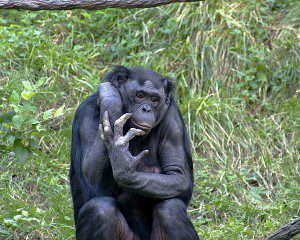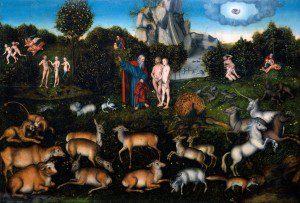One of my favorite writers of recent years, J. Richard Middleton, has joined BioLogos as a one of three 2016 Theology Fellows. As a fellow he will contribute six posts over the year on issues relating to the theology of creation. The first of these, Why Christians Don’t Need to be Threatened by Evolution, was posted today. Regular readers here will recall our long series of posts on Middleton’s books The Liberating Image: The Imago Dei in Genesis 1 and A New Heaven and a New Earth: Reclaiming Biblical Eschatology. Richard Middleton is Professor of Biblical Worldview and Exegesis at Northeastern Seminary (Rochester, NY) and has focused on the Old Testament. He isn’t a scientist and won’t argue evidence for or against evolution. Rather he will wrestle with theological questions that are raised by an old earth, evolution, and the antiquity of humankind. In his initial post he lays out some of the assumptions that will guide his future posts.
Middleton starts were all Christian thinking about creation and humankind should start, with Scripture. (You can read the full post at BioLogos.)
To start with, I take Scripture as providing the normative framework for the worldview of the church, with guidance for how to live in God’s world. The overarching biblical story of creation and redemption constitutes the non-negotiable framework for Christian discipleship; and serious immersion in Scripture—through gathered worship, communal study, and private meditation—is indispensable to the life of faith.
One part of Christian discipleship, or the life of faith, is how we think about the discoveries of modern science. How might the Bible guide us in that project?
The Bible is our central source as we develop an understanding of creation and humanity. It has to be taken seriously from beginning to end. But this isn’t a once and done project. The important questions of Christian faith have engaged the human imagination from the beginning of the church. Each new generation, and to an extent each individual Christian, must wrestle with these ideas again. This is how we learn and grow. Communal study is an important component of this. I look forward to Richard’s future posts.
 One of the strengths of Middleton’s approach is the focus on scripture in its ancient context. His book The Liberating Image is a fascinating study of the image of God. Many of the toughest issues raised in the church about evolution deal with human uniqueness. Are humans nothing more than animals? Simply self-aware arrogant apes? Do humans really have any ground to claim uniqueness and position? (Image Credit)
One of the strengths of Middleton’s approach is the focus on scripture in its ancient context. His book The Liberating Image is a fascinating study of the image of God. Many of the toughest issues raised in the church about evolution deal with human uniqueness. Are humans nothing more than animals? Simply self-aware arrogant apes? Do humans really have any ground to claim uniqueness and position? (Image Credit)
I will conclude the post today with a summary of Middleton’s conclusions concerning the imago Dei drawn from my earlier posts on the book. In The Liberating Image Middleton argues for a new interpretive framework for Genesis 1. God is portrayed as both artisan and ruler. He brought “into being a wisely crafted world through the exercise of royal power.” The world he created is not characterized by the imposition of a transcendent will or by a cosmic battle. It is also important to realize that the world was not created solely to serve mankind. Genesis 1 serves as a prologue that describes God’s good plan for his creation. The argument is fleshed out roughly as follows.
The Rhetorical Structure of Genesis 1. Although there are patterns in the creation story, these patterns are not rigid rhetorical structures from which we can draw deep truths concerning the nature of God’s rule and thus human rule as the imago Dei. It isn’t a set of propositions and should not be interpreted as such. This is a literary work with a degree of looseness and creativity. Genesis 1 depicts a creation where God intentionally shares power with his creation. The greater and lesser lights are not divine beings, but they are charged to rule the day and the night. The earth and the waters bring forth life.
On days 3, 5, and 6 (in 1:11-12, 20, 24), God invites the earth (twice) and the waters (once) to participate in creation by bringing forth living creatures. Whereas the earth is invited to produce first vegetation (1:11) and later land animals (1:24), the waters are invited to teem with water creatures (1:20). They are invited, in other words, to exercise their God-given fertility and thus to imitate God’s own creative actions in filling the world with living things. (p. 288)
Plants and animals are blessed with fertility to reproduce and fill the earth.
While these dimensions of the Genesis 1 creation story are not often noticed, attention to these rhetorical features points us to a God who does no hoard divine creative power, with some desperate need for control, but rather to a God who is generous with power, sharing it with creatures, that they might make their own contribution to the harmony and beauty of the world. (p. 289)
Beyond this humans are created in the image and likeness of God. They are commissioned to be fruitful and multiply, to fill the earth and subdue it, to rule over the creatures of the sea, sky, and land. Middleton points out, however, that humans do nothing in Genesis 1 except receive a blessing and commission. For the rest of the story we turn to Genesis 2-3.
 The Seventh Day. Middleton does not see Genesis 2 as an alternative creation story – one that contradicts or balances Genesis 1. Nor does he see Genesis 2 as an elaboration of Day 6. Rather he sees it, much like John Walton, as a continuation of the story. Genesis 1 is “a prelude to the rest of the Genesis narrative setting up the normative conditions for what follows.” (p. 291) There are two literary clues that point to this structure.
The Seventh Day. Middleton does not see Genesis 2 as an alternative creation story – one that contradicts or balances Genesis 1. Nor does he see Genesis 2 as an elaboration of Day 6. Rather he sees it, much like John Walton, as a continuation of the story. Genesis 1 is “a prelude to the rest of the Genesis narrative setting up the normative conditions for what follows.” (p. 291) There are two literary clues that point to this structure.
First, on the seventh day, following six days of creating, God rests. But in the structure of the narrative the seventh day has no end – the events of Genesis 2-3, and the rest of Genesis, and the Bible take place on the seventh day. God remains involved in his creation, and in relationship with his creatures, but God “rests” in 2:2 and continues to rest because the post creation rule has been delegated to the creation, and especially to humans.
Second, There is a tôlĕdôt structure outlining the generations in Genesis beginning with 2:4 “These are the generations of the heavens and the earth when they were created” (RSV, KJV, ESV …). This formula is found throughout Genesis dividing the book into 11 sections. In Genesis 2:4a the formula introduces the generations that follow from creation: human history beginning with Adam. But Genesis 1-2:3 precedes this tôlĕdôt structure. Middleton suggests that this means that Genesis 1 is a prologue to what follows.
The Trouble Begins. And in what follows the trouble begins … well not until Genesis 3. In Genesis 2 the man names the animals, is given a companion, marriage is instituted as a bond between a man and a woman, and the couple is placed in the sacred space of the Garden. The relationship between the man and the woman is not hierarchical but complementary. But it is downhill from there.
In Genesis 3, the primeval human pair rebel against God, and then the man begins to rule the woman (a rule that is not reciprocated) and names here Eve (thus treating her as he did the animals). In Genesis 4, Cain impulsively murders his brother Abel out of resentment, while he-man Lamech boasts to his two wives (the first reference to polygamy in the Bible) that he has in vengeance killed a youth for daring to injure him. And this violent propensity spirals out of control until in Genesis 6 humans fill the earth with their violence or bloodshed (hāmās), and the earth, which God created good, becomes corrupt and God is “grieved” (ˁāş ab) that he ever raised such an ungrateful brood of children (6:5-6). (p. 295-296)
The Liberating Image. Middleton’s view of the imago Dei in Genesis 1, emphasizes the function for which humans are set apart. The imago Dei is not a collection of special features of humanity – but a democratized commission. The term behind image (selem) refers most often to “a localized, visible, corporeal representation of the divine.”
When the clues within the Genesis text are taken together with comparative studies of the ancient Near East, they lead to what we could call a functional – or even missional – interpretation of the image of God in Genesis 1:26-27 … On this reading, the imago Dei designates the royal office or calling of human beings as God’s representatives and agents in the world, granted authorizing power to share in God’s rule or administration of the earth’s resources and creatures. (p. 27)
The function of humankind is to image the invisible God is his creation.
Genesis 1 as the opening chapter in the Bible separates human violence and domination from the nature of creation itself. When humans, created in the image and likeness of God, are told to rule over creation it isn’t a rule of power and domination but a rule characterized by creative love. Genesis 1:26-28 was a revolutionary text in the ancient Near East, democratizing the image of God from a singular king to all of human kind. Genesis 1 as a whole was also revolutionary because it shatters expectations of power, domination and conquest and instead “depicts God as a generous creator, sharing power with a variety of creatures (especially humanity) inviting them (and trusting them – at some risk) to participate in the creative (and historical) process.” (p. 296-297) God is a God of Love, for God is Love.
In the end, the liberating character of the imago Dei is grounded in the nature of God, who calls the world into being as an act of generosity. This means that we cannot artificially separate our vision of God’s redemptive love from an understanding of God’s creative power. In both creation and redemption, “God so loved the world that he gave …” (p. 297)
Evolution is no threat to the imago Dei because this isn’t defined by natural features. It may be important that we possess creativity and empathy, the ability to speak and reason and learn, a capacity for altruism as this enables us to fulfill our calling as the imago Dei. It is not important that other animals possess or lack elements of these same traits. Nor is it important how these traits developed in humanity – through evolution or special creation.
All in all a very interesting and thought provoking book. I highly recommend it. I anticipate an equally challenging and thought-provoking experience from Middleton’s upcoming posts at BioLogos.
What is our purpose and mission as the image of God in the world?
Is evolution a threat to the Christian understanding of what it means to be human?
If you wish to contact me directly you may do so at rjs4mail [at] att.net.
If interested you can subscribe to a full text feed of my posts at Musings on Science and Theology.















